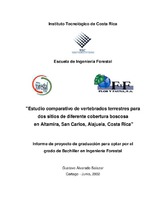"Estudio comparativo de vertebrados terrestres para dos sitios de diferente cobertura boscosa en Altamira, San Carlos, Alajuela, Costa Rica"
Abstract
Wildlife constitutes an important ecological, cultural, social and economic resource.
The forestry sector has the responsibility to design management systems that
incorporate wildlife in human development.
This study aims to be a precursor to a new and better forestry culture.
Additionally, the aim is to answer a question that has prevailed since the initiation of
the first plantations in Costa Rica:- Are forest plantations biological desserts?
The principal object is to compare the terrestrial vertebrates (birds, mammals,
herpetofauna) of two sites. The first site comprises natural tropical forest and the
second a plantation of Teak (Tectona grandis).
The project was founded on the grounds of “Hacienda Altamira”, belonging to the
company Flor y Fauna, S. A., situated in the district of Aguas Zarcas, canton of San
Carlos, province of Alajuela, Costa Rica.
The observations were undertaken over a period of one year (2001) with four visits
each quarter. Both direct and indirect observations were made of terrestreal
vertebrates excluding flying mammals (bats). Both static-point and walking /
horseback transect sampling methods were used. The information collected was
enhanced with photographic data and interviews witrh local citizens.
A total of 97 species was observed in the plantation area and 53 species in the
natural forest. A calculated S∅rensen index of 29,33% indicates that there is a low
species similarity between the natural forest and the plantation.
The conclusion is that, with 97 species distributed in in four classes, the Flor y
Fauna, S.A. plantation is not a biological desert. Besides being vastly different from a
natural dorest, the plantation constitutes an unexploited ecological importance. It
deserves to be studied with visionary interest.
Description
Proyecto de Graduación (Bachillerato en Ingeniería Forestal). Instituto Tecnológico de Costa Rica. Escuela de Ingeniería Forestal, 2002.


